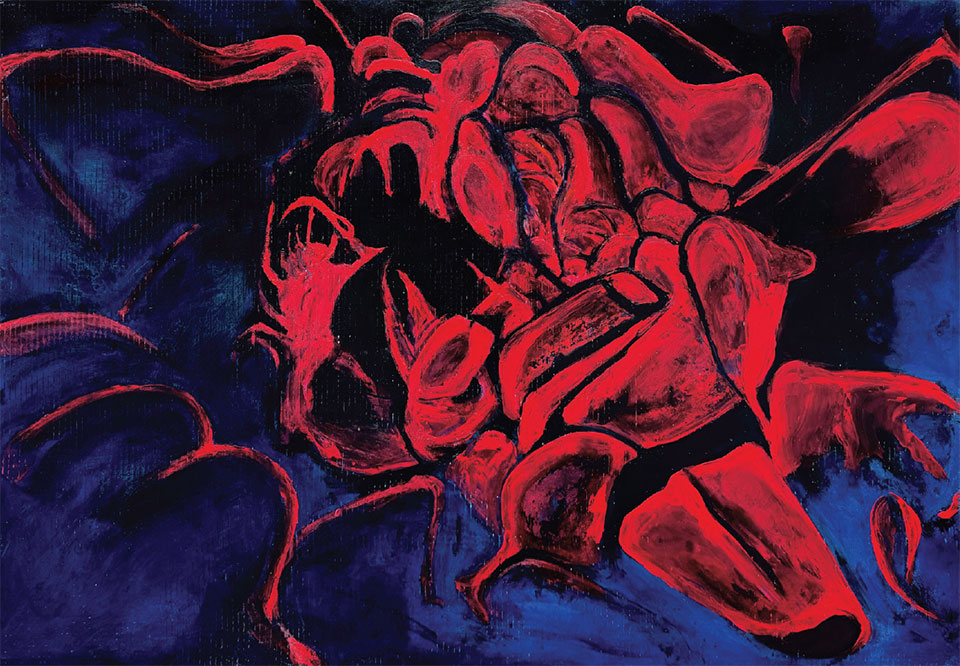Feathers, Bears, & Concrete
by Sabina Dana Plasse
Above: Exploded Rose | Integrally colored concrete | 48” x 71” – 33 lbs | Jon Nasvik
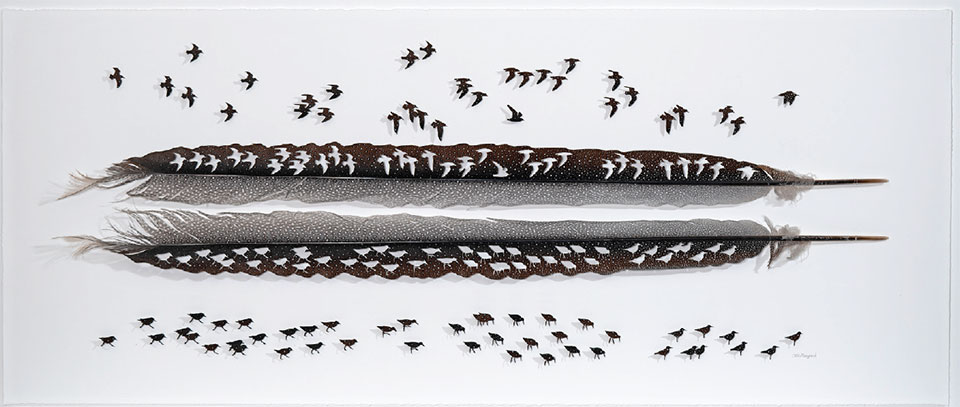
Wavelines | Great Argus tail feather | 24” x 55” | Chris Maynard | Gail Severn Gallery
Art critic Jerry Saltz calls art a “culture-scape” that reflects the times we live in, capturing our hopes, dreams, and anxieties. WHJ’s art feature showcases three regional artists whose work documents the culture-scape of Sun Valley and beyond. Washington-based Chris Maynard carves delicate dimensional stories in feathers, addressing themes of rebirth and the human survival instinct of hunting and gathering. Washington-based artist Robert McCauley uses bears and endangered species as allegorical symbols of mortality. Both Pacific Northwestern artists are represented by Gail Severn Gallery.
In a visceral contrast to the soft 19th-century Romanticism style of McCauley and the airy feathers in Maynard’s work, Jon Nasvik pioneers the medium of concrete in fine art. His landscapes reveal a novel lightness and the artistic potential of a material traditionally typecast as a solid utilitarian one, challenging our perceptions in a remarkable way. We hope you enjoy learning more about these artists and contemplating how their work will add to your collection.
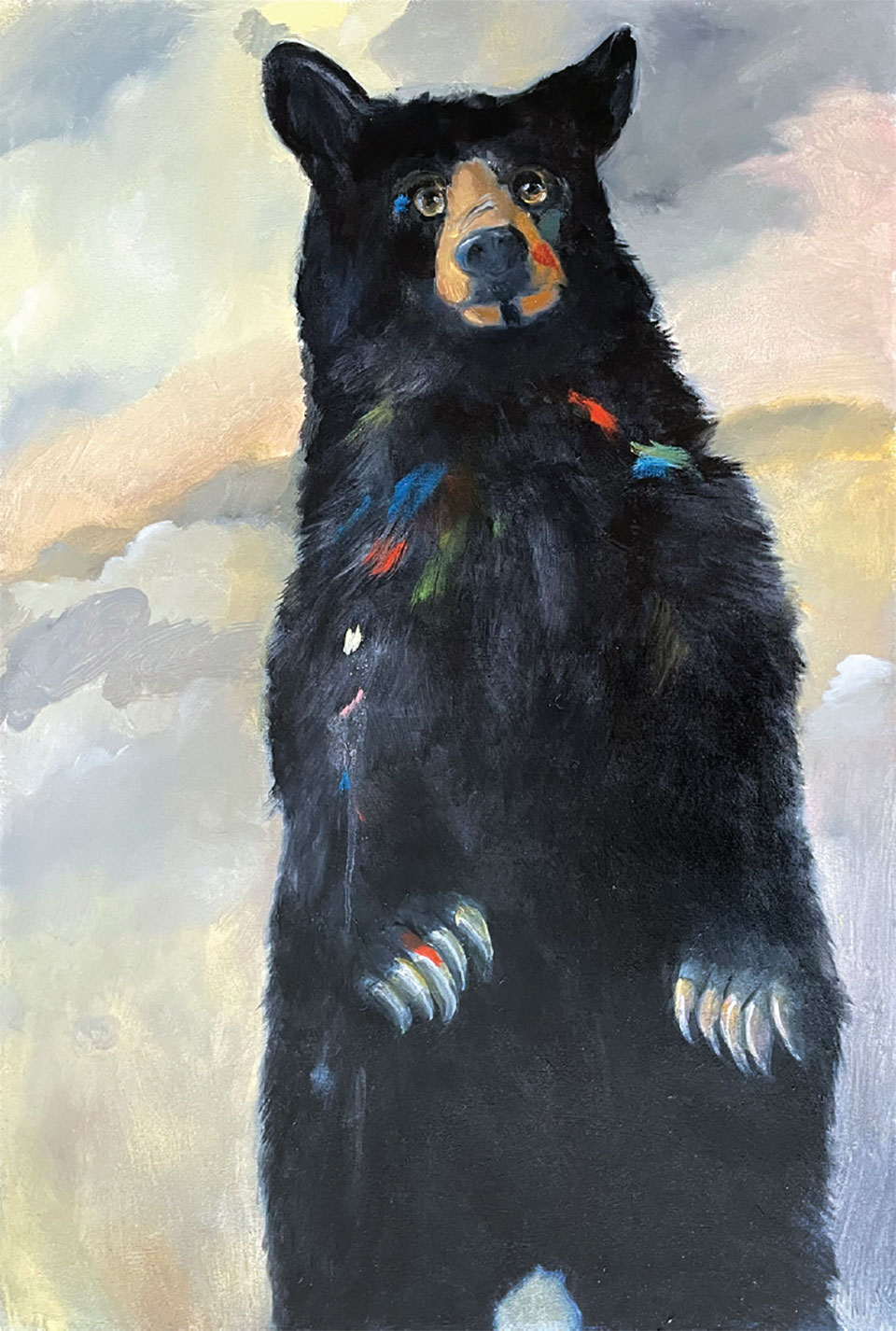
Painter | Oil on canvas | 36” x 24” | Robert McCauley | Gail Severn Gallery
Gail Severn Gallery
Man Versus Nature
Chris Maynard & Robert McCauley
by Lily Martin
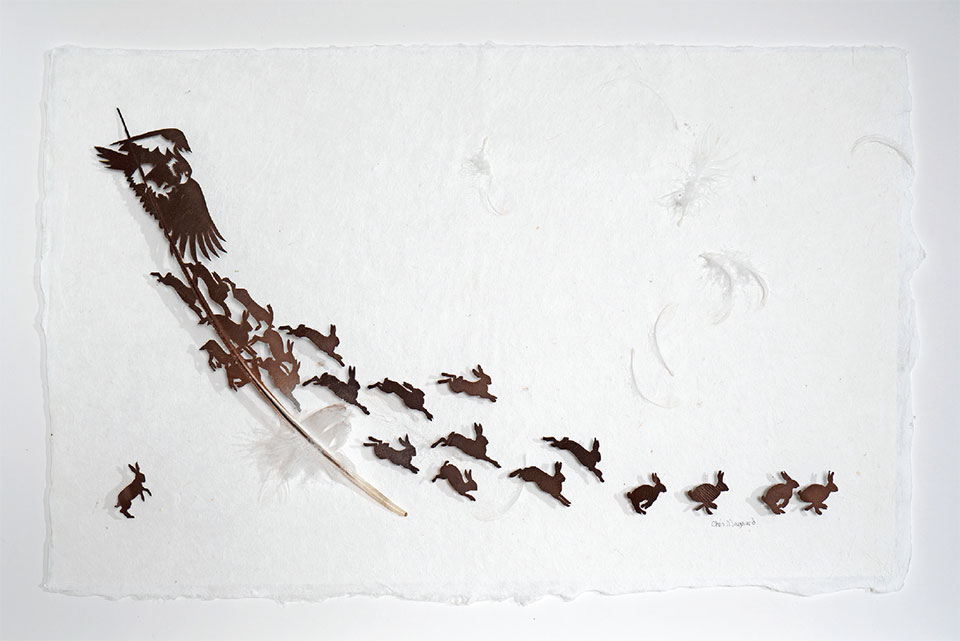
Eagles and Rabbits | Crowned Crane and Mute Swan feathers | 17.5” x 26” | Chris Maynard | Gail Severn Gallery
Chris Maynard and Robert McCauley are Pacific Northwest artists working in different mediums and styles, addressing similar themes of wildlife and subsistence. Chris Maynard’s specific fascination with birds and flight directly informs the subject of his work, as well as the unlikely medium of feathers. Robert McCauley tackles difficult ecological topics, illustrated through expressive portraits of the various creatures affected by growing environmental changes. Both artists approach their subjects with awe and reverence, representing different animals with agency and giving them an imaginative voice. Using unconventional techniques, elements of humor, and biological and environmental perspectives, Maynard and McCauley convey strong narratives that confront the viewer with another view of the natural world.
“As a visual artist, I attempt to capture an essence of life in an image. Because my medium is a tangible remnant of something living, I find it easier to capture this essence of life, which is so often elusive. For me, in this way, working with feathers is a direct connection between my art and the natural world.”
–Chris Maynard
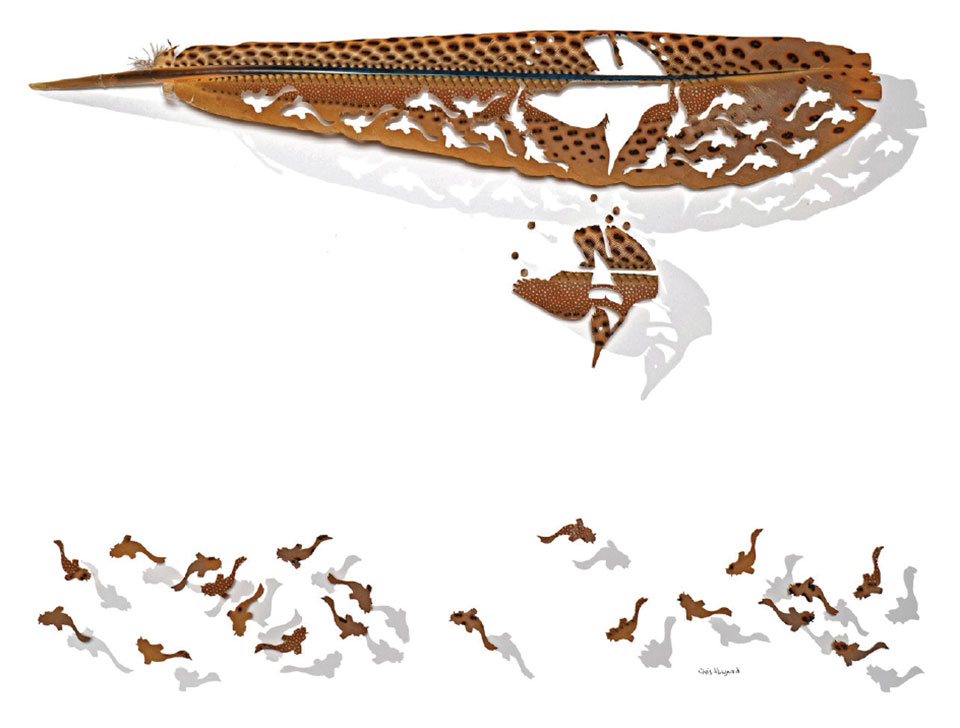
Goldfisher | Great Argus wing feather | 17” x 21” | Chris Maynard | Gail Severn Gallery
Maynard is enamored with feathers for their softness, strength, and beauty, as miraculous symbols of nature’s endless cycle of life. “As a visual artist, I attempt to capture an essence of life in an image. Because my medium is a tangible remnant of something living, I find it easier to capture this essence of life, which is so often elusive. For me, in this way, working with feathers is a direct connection between my art and the natural world.” Maynard also emphasizes the mystery of feathers, which arise as clues in determining the bird who left them behind. “I like to investigate to discover the tale of how the feather came to be in this particular place. This approach brings a refreshing attentiveness to my surroundings,” he says. Maynard considers the human impulse to explore and speculate to be rooted in our evolutionary wiring as hunter/gatherers. He strives to awaken this instinct deep within his viewers by inviting them to truly study and observe the visual puzzle presented by his work.
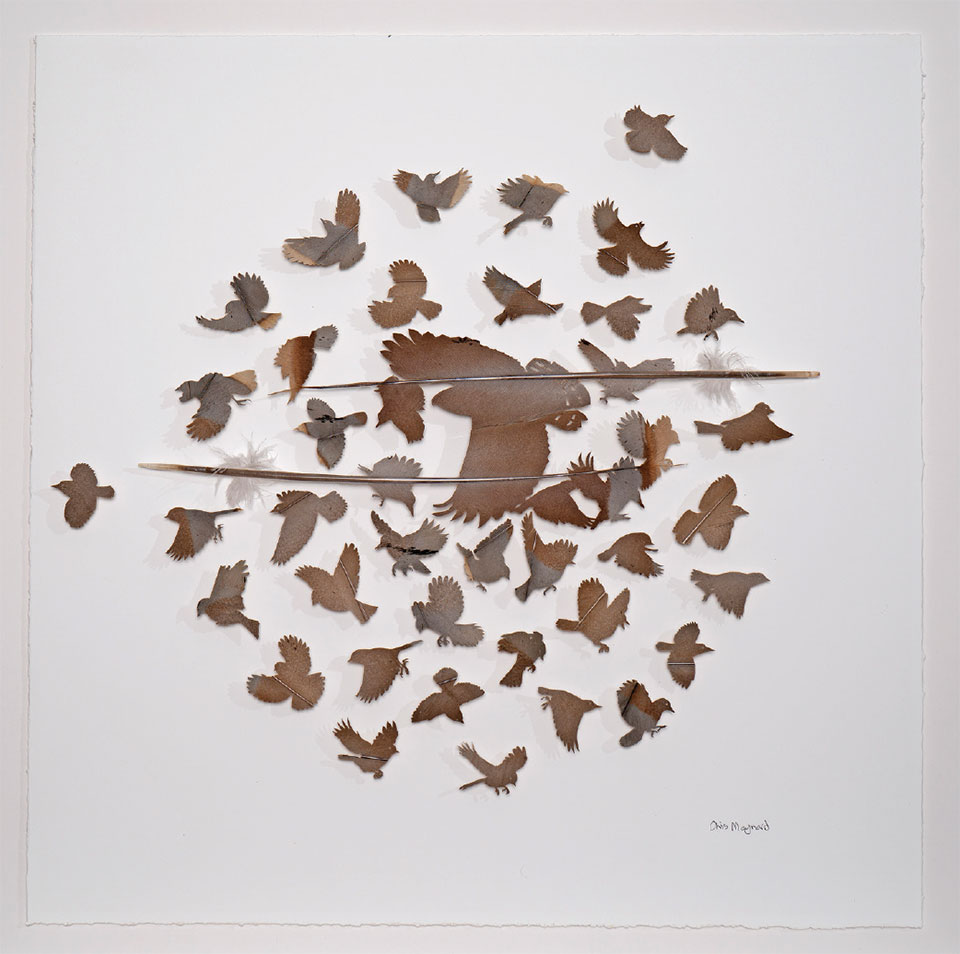
Rapere | Heritage Turkey feathers | 28” x 28” | Chris Maynard | Gail Severn Gallery
“Feathers have always held meaning for us (as humans) in our story, art, symbol, and myth. An individual feather tells two kinds of stories. It gives clues about the bird that grew to shed it.”
–Chris Maynard
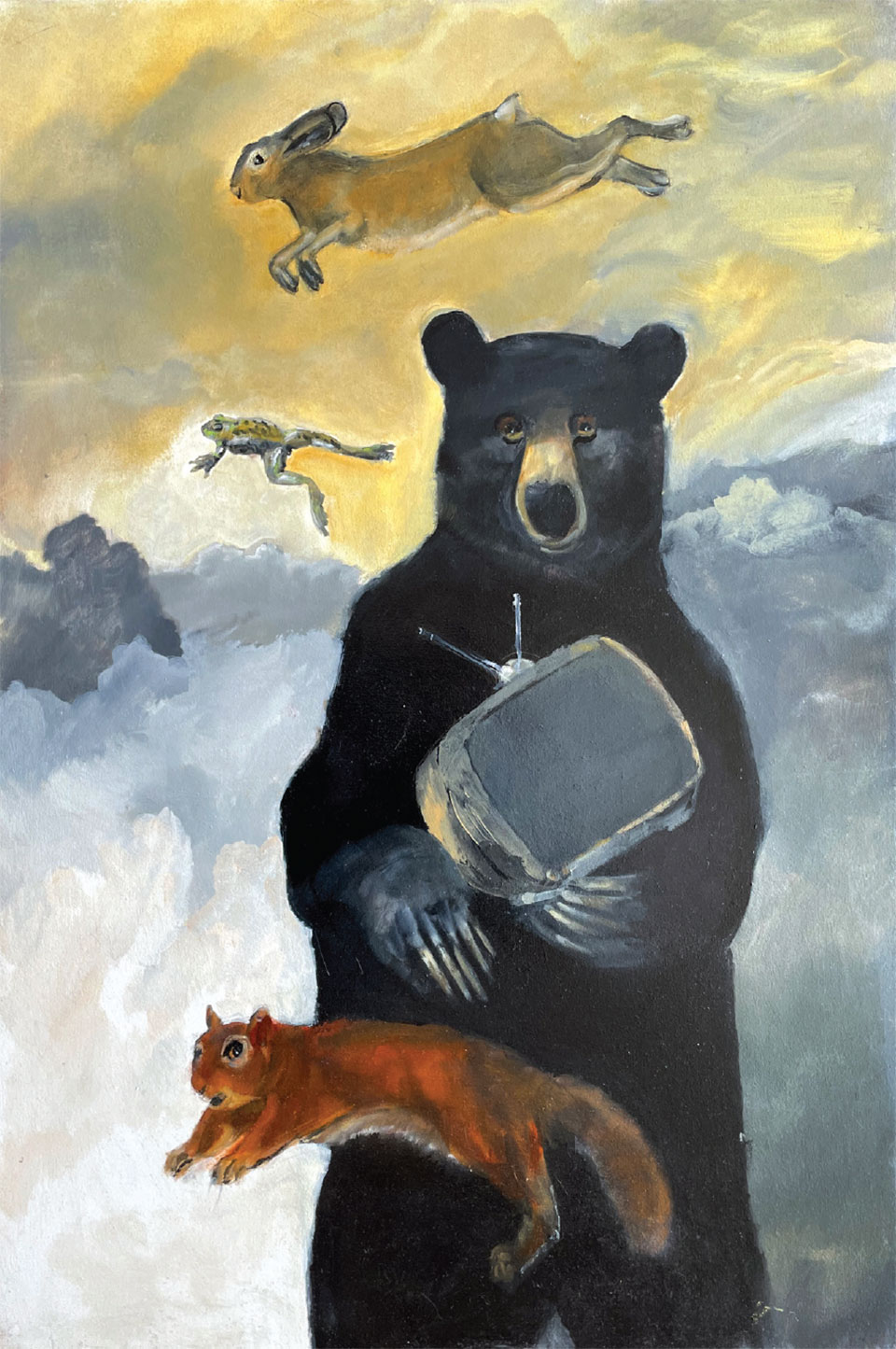
Abandoning the Sublime II | Oil on canvas | 36” x 24” | Robert McCauley | Gail Severn Gallery
Robert McCauley directs his focus toward animals threatened by extinction, especially bears due to their human-like qualities. With a style rooted in the tradition of 19th-century American Romanticism, McCauley addresses issues of hierarchies, culture clash, and environmental ethics. “As a painter-narrator, I am rewriting the relationship between man and nature, and nature and nature. Borders and climate zones dissolve, and adversarial roles fade away. ‘Predator’ and ‘prey’ are meaningless,” he says. McCauley demonstrates a remarkable ability to personify the bears and various animals he paints. Through the thoughtful rendering of the subject’s eyes, McCauley creates a sense of immediacy, eliciting genuine empathy from the viewer.
Maynard is inspired by the regenerative process of molting, explaining that “as birds grow new feathers each year and push out the old, the new ones become exact replicas of form and pattern.” Maynard elaborates upon this natural sequence in his artistic practice; collecting the naturally shed feathers and giving them new life within the narrative scenes of his work. Using only the feather itself, Maynard transfigures the raw material into positive and negative forms that reverberate throughout the composition. The empty spaces that Maynard cuts into the feather and the resulting extricates are equally central to the composition. Fittingly, these configurations unfold as fable-like origin stories explaining how certain birds came to be, the genesis of their various names, flight patterns, or even eating habits. The artist introduces a wide spectrum of avian creatures, ranging from a city pigeon to the Eurasian jay. Some of Maynard’s works take a playful, humorous tone, while others feel poetic, symbolic, or even parietal.
“As a painter-narrator, I am rewriting the relationship between man and nature, and nature and nature. Borders and climate zones dissolve, and adversarial roles fade away. ‘Predator’ and ‘prey’ are meaningless.”
–Robert McCauley
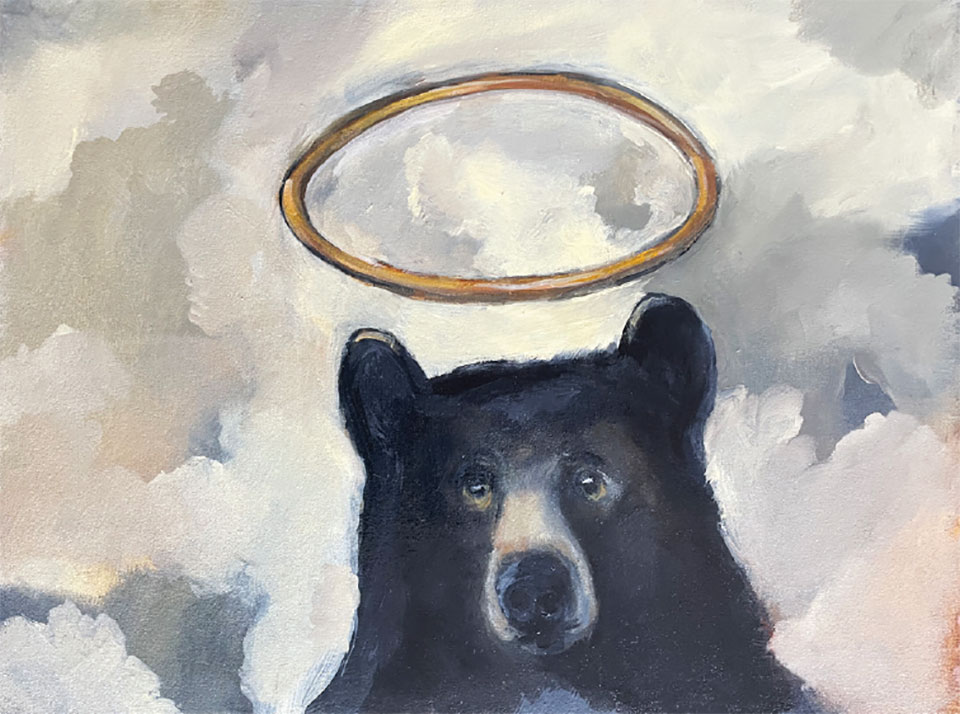
Good Boy | Oil on canvas | 18” x 24” | Robert McCauley | Gail Severn Gallery
Conversely to Chris Maynard’s interest in conception and rebirth, McCauley’s work signifies mortality. He grieves the rapidly changing landscape of the Northwest Coast of Washington where he spent his childhood. “The salmon streams I fished in are silted up and have no more salmon,” he says. “The Native Americans used to set a trap of chicken wire a half-mile out to sea, and I would watch the salmon in the trap in awe. That’s gone. Even the huge fishing resorts are gone because the fish are gone. Clear-cutting is still common. A small greenbelt of ten feet on either side of the roads makes you think you’re looking at forest, but beyond that it’s just devastation.” McCauley’s work straddles a dichotomy of what is at once deeply personal, yet overwhelmingly universal. He cleverly veils his paintings with a playful façade, surreal twists, and enigmatic text, all while addressing seriously relevant issues.
“The salmon streams I fished in are silted up and have no more salmon.”
–Robert McCauley
Both Chris Maynard and Robert McCauley project upon animals, as a vehicle to communicate their own unique philosophies. Maynard relies strongly on symbolism and allegory, explaining how “feathers have always held meaning for us (as humans) in our story, art, symbol, and myth. An individual feather tells two kinds of stories. It gives clues about the bird that grew to shed it. It also allures and engages us as a symbol of beauty and flight based on our experiences, desires, and beliefs.” In McCauley’s words, “my choice is to use the animal image as an anthropomorphic reminder that what we do to animals, no matter where in the world, is what we do to ourselves.” He looks to wild animals as a mirror, as living and breathing creatures, not unlike us. By bridging this gap between man and nature, perhaps the work of both artists can raise human consciousness and empathy toward the environment we share with our furry and feathered friends.
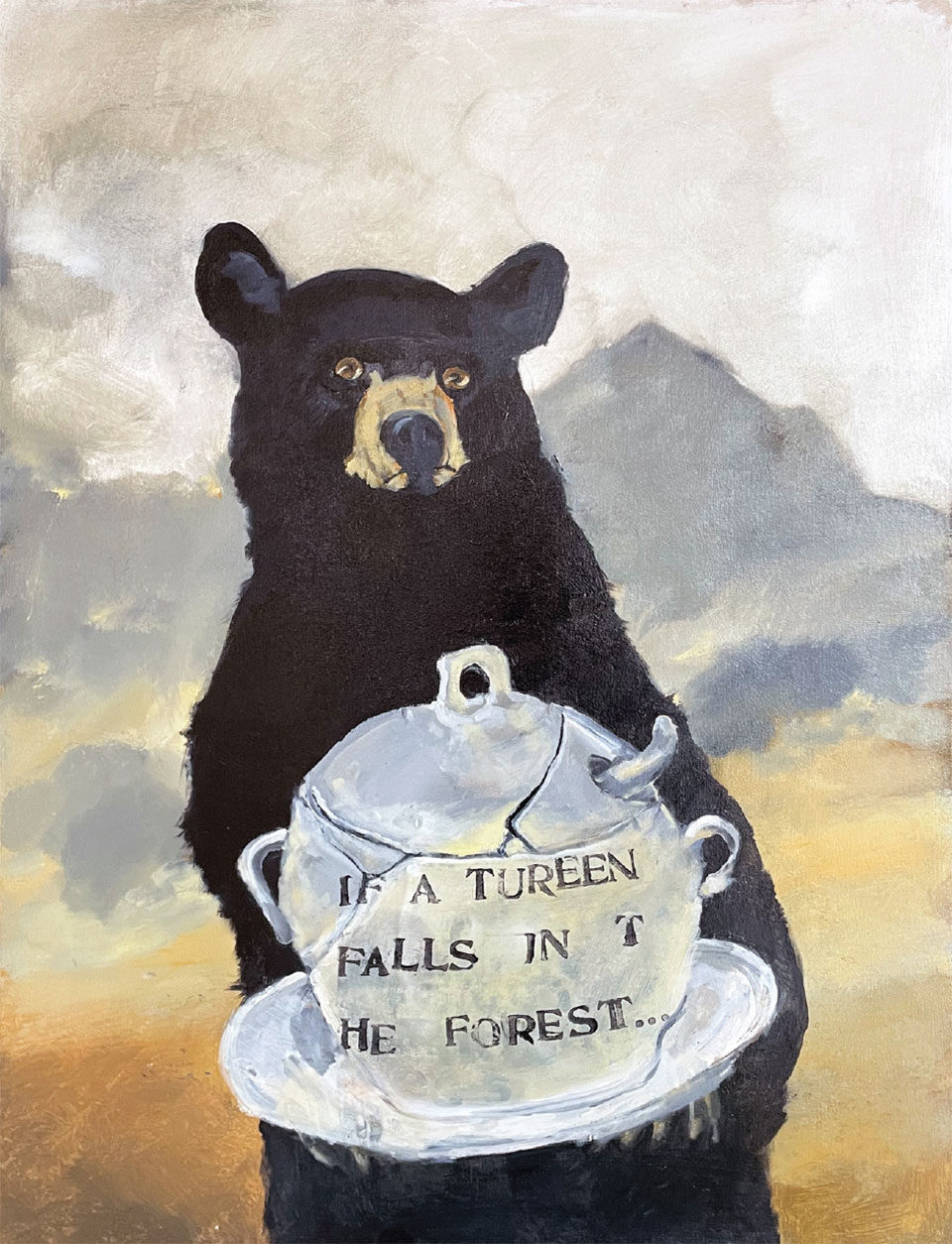
Tureen in the Forest | Oil on canvas | 32” x 24” | Robert McCauley | Gail Severn Gallery
Gail Severn Gallery has represented Robert McCauley for the last 30 years and is pleased to announce his solo exhibition of all new work. The show will run through December and January. There will be a preview of new work by Chris Maynard, whom the gallery has proudly represented for almost a decade, preceding his solo exhibition in March. Robert McCauley will be in attendance for the Gallery Walk reception on December 29 and will give an Artist Chat on December 30 at 10 AM at Gail Severn Gallery, located at 400 First Ave North in Ketchum.
For more information, please contact info@gailseverngallery.com or call 208-726-5079.
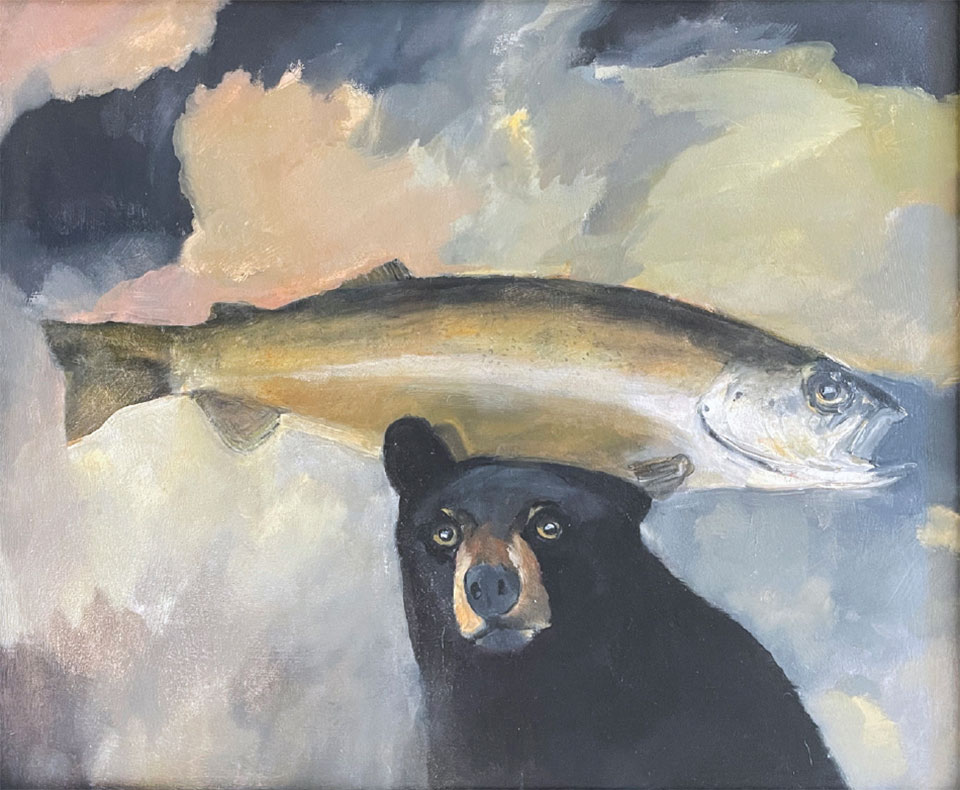
Hybrid | Oil on canvas | 24” x 30” | Robert McCauley | Gail Severn Gallery
Jon Nasvik On Concrete Art
Exploring Artistic Boundaries
by Sabina Dana Plasse
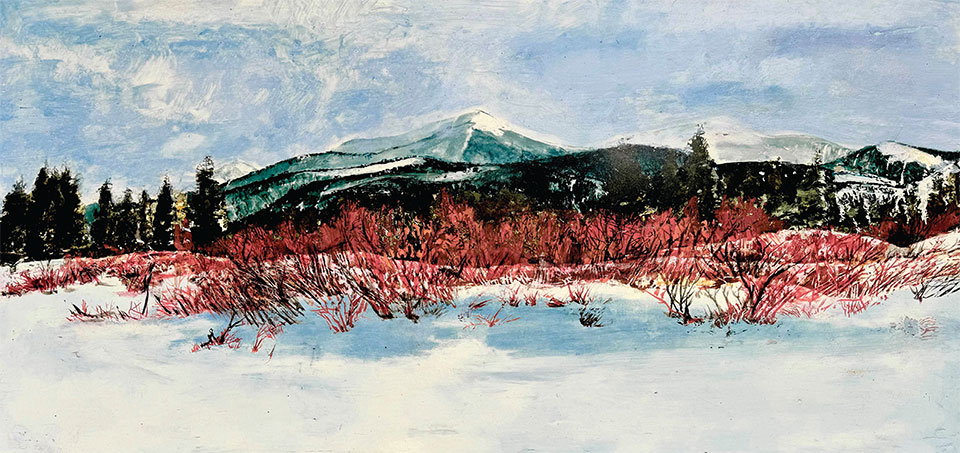
Red Willows | Integrally colored concrete | 23” x 48” – 19.5 lbs | Jon Nasvik
“Concrete art in particular has a certain essence of attraction. It’s sort of like being a method actor.”
–Jon Nasvik, Artist
When exploring fine art as décor or a collectible, it’s worth mentioning the unusual path with concrete that Sun Valley, Idaho, artist Jon Nasvik offers. A lifetime of experience with concrete has naturally inspired Nasvik to use it as a uniquely functioning art form. “I’ve reached a point as an artist where needing to produce, grow, and improve, and speak to what I’ve learned and feel have all come together,” he says.
The creative process for Nasvik is an extension of himself. It challenges him to push the boundaries into unknown areas. Because of its versatile cellular structure, concrete is a natural medium for expanding on the notions of art. As a foundation, it can provide an entirely new perspective with diverse textural opportunities that board and canvas don’t offer.
“I like to think of myself as an inventor searching for ways to express myself. This process seems to offer endless (toolbox) discoveries, motivating me to raise the bar and go farther,” says Nasvik.
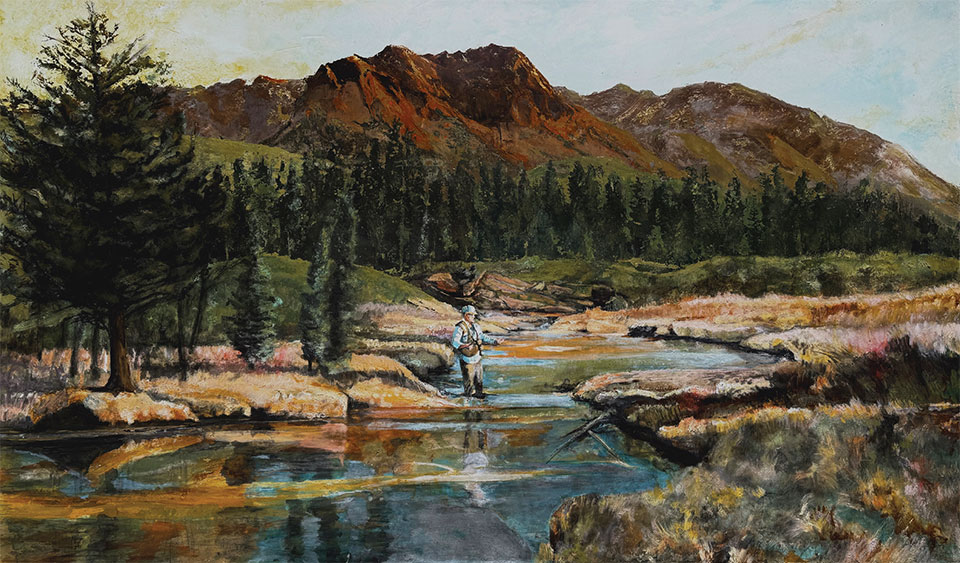
In The Moment | Integrally colored concrete | 48” x 81” – 39 lbs | Jon Nasvik
The idea of art and its role in our lives, coupled with Nasvik’s unique and evolving process, fuels creative appetite and begs conceptual questions like: What will it be, why is it important, is concrete the best choice for a particular idea, and how can the process be improved?
One of the rewarding moments in creating concrete art is the suspense of its unveiling. Usually, a piece is done upside-down and backward. Planning is limited because as layers of colored cement add up, previous layers get buried until, eventually, the whole piece is just one color. The unveiling comes after the artwork reaches its full 1/8” thickness and has had 24 hours to harden fully. Then, it gets flipped over and peeled off the plastic-coated plywood it was cast on to reveal the image—like how a print is done. If desired, there are options to apply more colored cement, stains, sanding, cutting, and grinding.
“Some clients view my work and appreciate the contemporary paintings. Others prefer my landscapes. They enjoy the look and feel, and, of course, they are surprised by what they’re made of,” Nasvik explains. “It takes viewers on a different adventure because it’s on its own path. I like that.”
“I thoroughly enjoy pioneering this art medium. Discovering new artistic elements in concrete doesn’t get old. Pushing through to new dimensions and experimenting has a very satisfying allure for me. And for others interested in discovering concrete art, I think it is an exciting find.”
–Jon Nasvik, Artist
He adds, “A common misconception about concrete art is its weight. I can’t stress enough that it does not have to be heavy. Most of my work is only an eighth of an inch thick, and it usually weighs about 1.25 pounds per sq foot. There is plenty of art on the walls where the frames and glass can weigh more than that.”
In a new work, Nasvik captures the mood of a central Idaho evening of fly fishing with definition and an enticing palette. As a landscape, the painting provides a cross-section of colors and textures to capture a moment in time. Color and forms move throughout the peaks and valleys of the concrete, adding dimensions and angles the individual can interpret in their own way. Nasvik’s contemporary piece has an airy, floating sensation with brilliant shades of red petals dancing in darkness.
“When I begin working, I can’t help getting lost in it,” says Nasvik. “Concrete art in particular has a certain essence of attraction. It’s sort of like being a method actor. While working on the landscape, I could almost feel the sun on my face, the stillness in the air, and the cool water at my feet.”
Jon Nasvik’s background as an artist has included working with various mediums: ink, oil, watercolor, lithography, photography, pottery, wood, metal, glass, and plastic; but, for the time being, concrete is just different enough to maintain his interest.
“I thoroughly enjoy pioneering this art medium,” says Nasvik. “Discovering new artistic elements in concrete doesn’t get old. Pushing through to new dimensions and experimenting has a very satisfying allure for me. And for others interested in discovering concrete art, I think it is an exciting find.”
To learn more about Jon Nasvik and his concrete art, visit jonnasvik.art.

Riparian Woodland | Integrally colored concrete | 4’ x 12’ | Jon Nasvik
